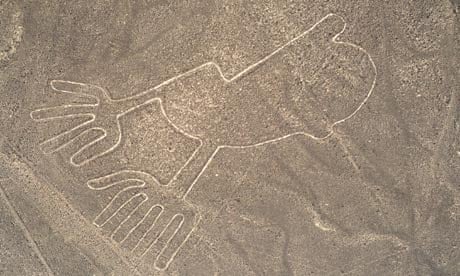The ancient Nazca civilisation of Peru, made famous by the giant geoglyphs it left etched in the soil, partly triggered its own downfall by chopping down forests and creating a desert, according to researchers.
The society vanished 1,500 years ago after flourishing for centuries, during which it made sophisticated arts and crafts as well as the famous Nazca lines. A study published today suggests its collapse was caused by the clearing of huarango trees, which had maintained an ecological balance in that corner of South America.
The Nazca wanted land for corn and other crops and did not realise the forests were crucial to soil fertility and moisture, said the Cambridge University-led report. "In time, gradual woodland clearance crossed an ecological threshold – sharply defined in such desert environments – exposing the landscape to the region's extraordinary desert winds and the effects of El Niño floods," said David Beresford-Jones, from the McDonald institute for archaeological research at Cambridge University.
The findings contrast with the stereotype that Native Americans lived in harmony with nature until the voracious European conquest, and follows reports that other ancient cultures suffered similar fates: the Maya of central America abandoned their cities and pyramids after over-intensive use of water and land, while the tribes who erected giant stone statues on Easter Island all but died out after clearing too many trees.
The Nazca – also spelt Nasca – thrived in arid valleys of what is now the southern coast of Peru between 300BC and AD800. In addition to the geoglyphs, which endure to this day and are visible from space, they built the ceremonial city of Cahuachi and underground aqueducts. Researchers found more than 60 huarango stumps preserved in the Samaca basin. Pollen samples indicated forests were replaced by fields of cotton and corn.
The short-term agricultural gain came at a high price because the trees anchored the landscape. "It is the ecological 'keystone' species in this desert zone, enhancing soil fertility and moisture, ameliorating desert extremes in the microclimate beneath its canopy and underpinning the floodplain with one of the deepest root systems of any tree known," said Beresford-Jones.
Clearances reached a tipping point at which the arid ecosystem was irreversibly damaged, leaving it vulnerable to a big El Niño-style event around AD600 which unleashed strong winds and catastrophic floods, rendering land unusable for agriculture and, eventually, creating a desert.
Had the forests still stood they would have cushioned the impact, said the study. Instead, the Nazca endured resource wars and their civilisation eventually suffered a "catastrophic" collapse.
The Nazca study's authors said their findings had contemporary resonance. There are now no undisturbed ecosystems in the region the Nazca used to call home. What remained of the old-growth huarango forests is being destroyed by illegal charcoal-burning operations.
"The mistakes of prehistory offer us important lessons for our management of fragile, arid areas in the present," said Oliver Whaley, of the Royal Botanic Gardens, Kew.
The Nazca
The Nazca people carved out a civilisation in southern Peru's arid valleys long before the Inca empire. They are best known for the Nazca lines: vast, intricate drawings etched on the desert floor, possibly sacred pathways. In addition to sophisticated pottery and textiles, the Nazca amassed one of South America's biggest collection of human trophy heads. The skulls had a hole drilled into the forehead. Academics disagree over whether the heads were of distant enemies killed in battle or sacrificial victims from closer to home.
